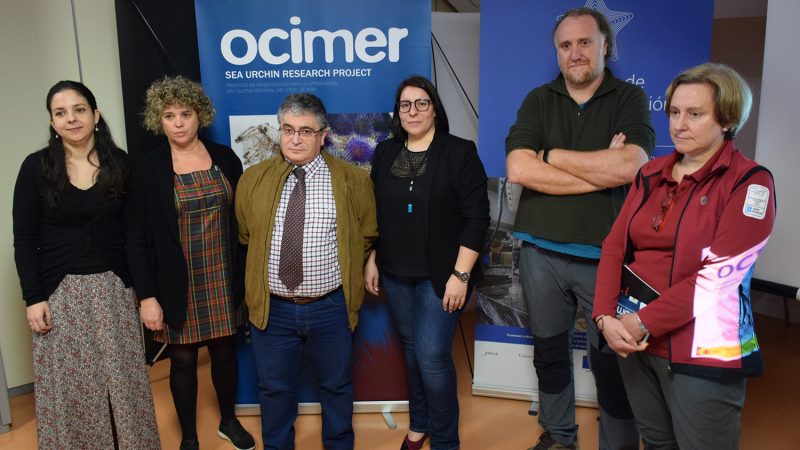The sea urchin is a fishery of high commercial value and its consumption can be traced back to prehistoric times, but the overexploitation of natural banks has in recent years caused a significant decrease in the global exploitation of this species, of which Galicia is the main producer in Europe. To cope with this situation, countries such as Japan or the USA, two of the world’s largest producers, began betting on aquaculture and developing exploitation plans and repopulation experiments on a pilot scale. It is in this context in which the Ocimer project arises, an initiative of the Toralla Marine Science Station (Ecimat, CIM-UVigo) for the optimization of the integral culture of sea urchin Paracentrotus lividus (Lamarck, 1816). With two years of duration and a total budget of 148,420 €, the project is part of the Pleamar call, promoted by the Biodiversity Foundation, an entity that finances 70% of the total costs, thanks to funds of European Maritime and Fisheries Fund (FEMP). The participation of the ECIMAT is cofunded by the Xunta de Galicia and the European Union through the ERDF Operational Program Galicia 2014-2020.
This Wednesday, its officials presented the main lines of research at the headquarters of the National Park of the Atlantic Islands, a partner of the project together with the Fishermen’s Association San Xosé de Cangas. The general objective of the project is to implement new optimized cultivation techniques and sea urchin repopulation methodologies, which contribute to improving the quality of the gonads produced, extending their marketing period in the purchased, as well as the recovery of the populations of areas overexploited and associated fishing activity. For this, we will proceed to repopulate with 30,000 copies of overexploited areas of the Vigo estuary, as advanced by the technique responsible for the project, Noelia Tourón. “We are going to make small experimental releases to evaluate the recovery and survival rate and then the repopulation will be done on a larger scale, probably in the Cies Islands.” The researcher had recalled that, given the exponential increase in the price of this product year after year, “it is becoming profitable to make native urchin farms, and it is expected that in a few years the production will increase greatly, both for the national market and for export ”, since Galician production is mainly destined for France and Belgium. In addition, within the framework of the project, work will also be carried out on the optimization of all the culture phases “so that the greatest number of juveniles are produced in the shortest possible time and growth diets will be implemented”, with which they expect to obtain a rate 60% survival.
Sustainable fisheries and biodiversity conservation
The presentation ceremony was opened by Jose Manuel García, director of the Ecimat and Montserrat Martínez Morán, deputy director of the National Park of the Atlantic Islands of Galicia, who emphasized the importance of this type of projects with the national park, “A controlled place that brings many facilities for research”. García, as IP of the Ocimer project, recalled that the sea urchin “went from being a secondary species to being a product with a huge demand that forced the development of exploitation plans that ensure the sustainability of this resource.” The project is a commitment of Ecimat in this line with the objective of “promoting fisheries and aquaculture sustainability as well as the conservation of its biodiversity”. He said the research team will focus on three main lines of work. One of them is aimed at breeding and repopulation in fishing extraction areas, optimizing the production process of juveniles and focusing, above all, on the fixing and metamorphosis phases, for which they have the collaboration of the Fishermen’s Association of Cangas. In relation to this line, García pointed out, “an aspect that concerns us is the conservation of the urchin’s biodiversity in the environment of the Atlantic Islands National Park and, in this sense, a biobank of native species will be created, for which, protocols for cryopreservation of biological and reproductive material from different local sea urchin species will be developed”. A third line of research involves designing diets that improve the condition, texture and color of the urchin gonads before commercialization.
Together with the project manager researcher, Jose Manuel García, they are involved in Ocimer Damián Costas, responsible for the Biological Resources and Marine Crops Unit of Ecimat and Estefanía Paredes, researcher of the EcoCost group of the CIM-UVigo and responsible for the Functional Preservation Service of Marine Organisms of the Ecimat. At the close of the project, the team will create a comprehensive culture manual for Paracentrotus lividus and they hope to publish the results in international scientific journals. All the advances that are made can be followed through social networks in @ ocimerUvigo.
A species of high ecological and commercial importance
The sea urchin is a species of high ecological importance since, as the researcher Noelia Tourón explains, “ they make up the most important biomass of the seabed and are great regulators of macroalgae, modifying even the composition and richness of bottom species”. The scientist also highlights their vulnerability, given that when they reproduce, “they form large urchin banks, so overfishing and illegal fishing affect them a lot, being also a kind of slow growth”.
But, they not only have ecological importance, but also commercial and its value has increased exponentially in recent years. Galicia is the main producer in Europe and, since the 2000s, production remained at around 750 tons/year. Prices increased significantly, reaching the maximum in 2016, with 7 euros/kg annual average and peaks of more than 20 €/kg. Thus, in the last two years, Galicia registered an annual volume of 4.5 million euros of economic value, more than double that registered two years earlier.
Source: DUVI

